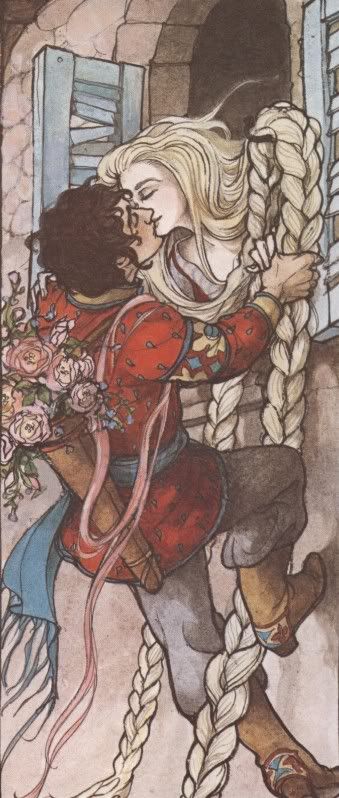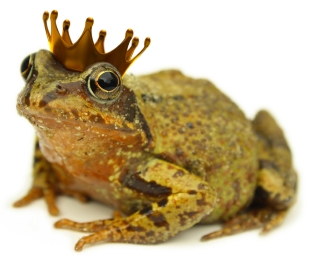The modern Fairytale has developed certain expectations, whether you recognize them or not. There are recipes that have become a staple in the tales and myths surrounding folklore. The first is that the story must begin with: Once Upon a Time, then through exposition we are introduced to a character who has experienced some form of hardship whether it's social status, economic hardship or simply put, a curse. As with most enchantments we come to expect that the only way a spell can be broken is not necessarily by fighting dragons or finding the right counter-spell but through an act of innocence, True Love's Kiss. This act has become almost as prevalent as the opening and conclusion of modern fairytales. When we think about Snow White and Sleeping Beauty they are tied together by True Love's Kiss, for it was the Prince who came to wake them from their enchantment. And as for the cursed Frog Prince, it is widely accepted that it was a kiss that lifted his curse, this is not really the case. While we see these acts through out the media, through children books and now big budgeted movie productions we stride further from more grim elements that made these tales stand out. There is irony in the largest collections of folktales, even in Jacob & Wilhelm's last name: Grimm, for that's what they were, dark and gruesome. Witches were more than old hags, they were wicked and malevolent, most wanting to destroy any and all who had the potential to gain any power over them. In the whole catalog of fairytales there are actually few circumstances where True Love's Kiss held any power, it is the advent of a modern desire for repetition and expectation. Most tales are shared as: Faithful Retellings, they are anything but.
 |
| 'Rapunzel',Trina Schart Hyman 1982 |
The original version of the Frog Prince saw a lonely frog who in returning a priceless golden ball to a carless Princess is granted his greatest desire. The Princess loses the item to a deep pool of water and cannot retrieve the object herself.
 |
| plus.maths.org |
"Whatever you like, dear frog," said she; "any of my clothes, my pearls and jewels, or even the golden crown that I wear." (Here it is understood that the little creature is not wearing a crown or any other item that might expose his true form, although in recent culture we always see him depicted with a tiny crown.)
"Your clothes, your pearls and jewels, and your golden crown are not for me," answered the frog; "but if you would love me, and have me for your companion and play-fellow, and let me sit by you at the table, and eat from your plate, and drink from your cup and sleep in your little bed---if you would promise all this, then would I dive below the water and fetch you your golden ball again." ---Brothers Grimm
 |
| Janet & Anne Grahame Johnstone, Dean's: A Book of Fairy Tales 1977 |
After the ball is retrieved the Princess runs from the small creature ignorant of her promise. Later he comes knocking upon the palace door demanding what was promised to him. When the King learns of his daughters promise he orders that she must see it through. This perhaps is a lesson to what seems a very spoiled Princess. After feasting with the frog and letting him eat off of her plate the Princess is mortified.
 |
| Janet & Anne Grahame Johnstone, Dean's: A Book of Fairy Tales 1977 |
Then the King's daughter began to weep, and was afraid of the cold frog, that nothing would satisfy him but he must sleep in her pretty clean bed. now the King grew angry with her, saying, "That which tho hast promised in thy time of necessity, must tho now perform."
So she picked up the frog with her finger and thumb, carried him upstairs and put him in a corner, and when she had lain down to sleep, he came creeping up, saying, "I am tired and want to sleep as much as you; take me up, or I will tell your father."
 |
| Arthur Rackham, Fairy Tales of the Brothers Grimm 1900 |
But as he fell, he ceased to be a frog, and became all at once a prince with beautiful kind eyes. And it came to pass that, with her father's consent, they became bride and bridegroom." ---Brothers Grimm
Originally this tale had no moment even closely resembling True Love's Kiss, it is the Princesses' brut rage that breaks the spell upon the poor creature and in it's glory this tale is successful without kisses. The twisted notion of having a a slimy creature in your clean silky bed is the original element that made this tale memorable. (*Frogs make appearances in many other familiar tales. The other most notable appearance is in the beginning of Sleeping Beauty, when a Queen is bathing in a pool and is told by a frog who emerges out of the water that she will bare a child. It is sort of gruesome thinking about frogs watching women silently, even more disturbing them watching Queens, for as in the Frog Prince's tale perhaps it was he who calculated everything. Ewe.)
Another circumstance where True Loves Kiss is not the element that breaks a curse is found in Snow White and the Seven Dwarfs. This is rather disheartening for all children who grew up watching this...
 |
| Walt Disney's Snow White and the Seven Dawarfs |
'The dwarfs, when they came home in the evening, found Snow-White lying on the ground, and there came no breath out of her mouth, and she was dead. They lifted her up, sought if anything poisonous was to be found, cut her laces, combed her hair, washed her face with water and wine, but all was of no avail, the poor child was dead, and remained dead. Then they laid her on a bier, and sat all seven of them round it, and wept and lamented three whole days. And then they would have buried her, but that she looked still as if she were living, with her beautiful blooming cheeks.
| Charles Santore |
So they said, "We cannot hide her away in the black ground." And they had made a coffin of clear glass, so as to be looked into from all sides, and they laid her in it, and wrote in golden letters upon it her name, and that she was the King's daughter. Then they set the coffin out upon a mountain, and one of them always remained by it to watch. And the birds came too, and mourned for Snow-white, first an owl, then a raven, and lastly, a dove.
Now, for a long while Snow-white lay in the coffin and never changed, but looked as if she were asleep, for she was still as white as snow, as red as blood, and her hair was as black as ebony.
| 'Snow White' by Marianne Stokes |
But the dwarfs told him that they could not part with it for all the gold in the world. But he said, "I beseech you give it to me, for I cannot live without looking upon Snow-white; if you consent I will bring you to great honor, and care for you as if you were my brethren."
| Belz & Gelber |
| 'The Glass Coffin', Paul Hey |
The most bizarre and disturbing way that a Princess is awoken occurs in one of the earliest versions of Sleeping Beauty predating the Brothers Grimm, written in the 1600's. The majority of tales that the Brothers Grimm collected were directly from French and Germanic oral tradition. Sleeping Beauty's oldest variant comes from Italy by an author named Giambattista Basile. Basile's tale sees a young Princess who is cursed into a sleeping death by means of a splinter of flax that becomes lodged into her fingernail. The Princess, named Talia is left upon her velvet throne by her father, who's grief leaves him to abandon the palace without her remains. After much time has past she is discovered by another King who climbs into the abandoned palace. After he finds the sleeping beauty he cries aloud that he cannot wake her, then proceeds to carry her to a bed and rape her. Afterwards he abandons the Princess and travels back to his palace. In her unconsciousness she births two twins. One of the hungry infants sucks upon her finger and removes the splinter of flax. Later it is revealed that before he happened upon the Princess the King was married. The second half of the story surrounds the Queens efforts to have the twins killed. At one point she orders the Royal Cook to prepare the twins into a dinner for the King, who is unaware. The Cook cannot complete this task and prepares lamb to convince the Queen. The Queen who thinks herself successful, announces to the King after he compliments the food, "Eat,eat, you are eating of your own." The evil Queen invites Talia to her kingdom with the plan to burn her alive. After the King Discovers the truth of her actions he turns around and has his Queen burned, along with everyone who betrayed him. Talia and the King then marry and live happily ever after.
Read the full version Here.
 |
| Arthur Rackham, Richard Wagner's Die Walküre 1910 |
Source Material:
- Grimm's Complete Fairy Tales, Barnes & Noble 1993 Edition
- Sleeping Beauty--- Giambattista Basile (The Sun, Moon, and Talia), uncoy.com
- Wikipedia.com
- Dictionary.com

No comments:
Post a Comment